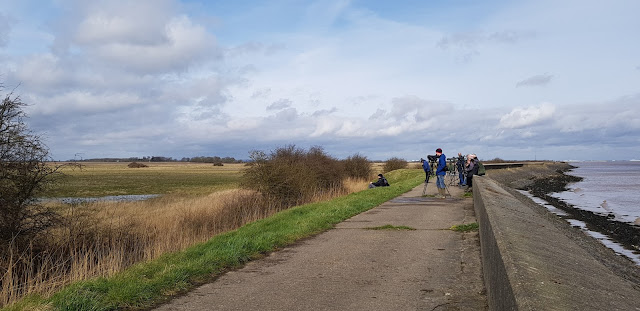I started in usual style by parking at Winter's Pond,got several layers on and the pack up in the ruck sack and off i went.
First nicetie was a couple of Whimbrel flying over east towards Killingholme and the unfortunate sight of the Great-crested Grebe pair attempting to repair their nest which had been washed out due to the rise in water levels and blustery wind,hopefully they will eventually be success full.
As i walked it was really difficult to try and hear any singing birds,so i eventually gave up trying to count singing males of species as i usually do and tried to concentrate on the Humber and anything passing by,when i flushed a Common Sandpiper half way between Winter's and the Skitter,at last something of note.This was my first of the year and certainly made the effort of coming out today a bit more bearable.
As i arrived at the Skitter,it seemed to be birdless,but then i managed to spot a wader bathing in the edge of the Haven,a gorgeous summer plumaged Black-tailed Godwit.I rattled off several photos of this lovely brick red wader and then carried on my way.
A quick look on the inland fields saw 4 more cracking Whimbrel as they fed in a wet area in one of the pastures and i enjoyed some lovely views of a singing male Lesser Whitethroat.
I then decided to head inland along Skitter beck when i received a text from Paull birder Simon Brebner to say he had just had a flock of 6 Scaup drifting past the Skitter,the trouble is i was half a mile away!.I walked back to the Skitter as quick as i could and attempted to see them,but i just couldn't be sure after seeing something miles away sat on the river,oh well you can't see them all.
Plenty of scanning over the Skitter pools revealed a hand full of Swallows and a further 7 flew west,before i cut inland to walk along East Marsh lane up to Goxhill Haven.
Very little of note was found along this section of the patch,apart from the small Rookery near the horse stables.I just love to hear the squabbles and sounds of Rooks,with several chicks begging for food,just brilliant to see and hear.
As i arrived at the Haven,i walked up onto the bank top to see a white arse disappear infront of me and i quickly relocated the bird,a female,my first local bird of the year.She showed nicely,briefly,before reverting to more typical Wheatear behaviour and buggering off.Also here was a single Whimbrel which showed well also,before it flew off east.
A decent bit of activity between Goxhill Haven and East Halton Skitter saw 12 Swallow on Dawson City feeding over the pit and i grilled them intently for a Red-rumper,but to no avail and a little further on a Cuckoo brightened proceedings a little.
Finally with 11 odd miles walked i arrived back at Winter's Pond to the sight of a mixed flock of Hirundines feeding over the pit,which consisted of 17 Sand Martin,7 Swallow and 12 House Martin making for a lovely sight,as 3 Yellow Wagtail fed nearby,a decent end to the days visit,just as it began to rain.
It was really hard going today in the blustery northerly wind,but 2 more additions to the patch year list is better than nothing,onwards and upwards.
 |
| Black-tailed Godwit,East Halton Skitter. |
 |
| Black-tailed Godwit,East Halton Skitter. |
 |
| Having A Doze,The Stunning Black-wit,East Halton Skitter. |
 |
| Female Wheatear,Goxhill Haven. |
 |
| Female Wheatear,Goxhill Haven. |
 |
| Whimbrel,Goxhill Haven. |
 |
| Whimbrel,Goxhill Haven. |
 |
| Male Yellow Wagtail,Winter's Pond. |




























